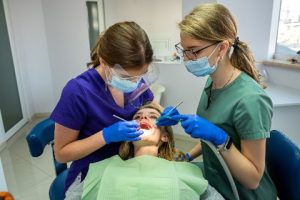 Dentistry was once a one-person profession. Dental assistants were relegated to the back room, while the dentist handled treatments. Today, a new technique called four-handed dentistry makes a dental assistant a key player in most chairside procedures. The benefits to patients and dentists can’t be understated.
Dentistry was once a one-person profession. Dental assistants were relegated to the back room, while the dentist handled treatments. Today, a new technique called four-handed dentistry makes a dental assistant a key player in most chairside procedures. The benefits to patients and dentists can’t be understated.
What Does a Dental Assistant Do?
Dental assistants handle administrative and clinical tasks in dental practices. The job description includes:
Managing the Schedule
Dental assistants know how much time treatments take, so they collaborate with the front office team on the schedule. They troubleshoot emergencies and make urgent appointments, ensuring prompt care while keeping busy days on track.
Welcoming Patients
Many adults have dental phobias ranging in severity from general anxiety to fear. The first interaction they have with team members has a significant impact on how the practice is perceived. Dental assistants take the reins as soon as patients arrive, answering questions while putting them at ease. As dental ambassadors setting the first impression, they represent the entire team.
Updating Dental Records
Dental visits begin with a review of the client’s medical and dental records. Certain medical conditions, allergies, and prescription drugs can impact treatment choices, so they update this information before the dentist arrives.
Taking Vital Signs
Not all practices take vital signs. It’s more common in oral surgery clinics. Still, the push is on to improve safety at all levels of dentistry. And some dentists are participating in a nationwide initiative to monitor blood pressure.
Prepare Treatment Rooms
Dental assistants stock treatment room shelves, and prepare the equipment and supplies needed for procedures. They also monitor inventory and order supplies.
Sanitation, Disinfection, and Sterilization
Disease can spread quickly in unsanitary conditions if treatment areas aren’t properly cleaned. One of the most pressing responsibilities as a dental assistant is to avoid the risk of infection by sanitizing surfaces, disinfecting equipment, and sterilizing instruments.
Helping in the Lab
Many practices have full-service laboratories in which they create dental appliances, such as crowns, dentures, bridges, and retainers. Dental assistants help by taking mouth impressions, polishing appliances after adjustments, and cementing protective, temporary crowns into place until permanent crowns are molded.
Polishing Teeth
Dental assistants don’t perform cleanings in most states, but they can polish teeth ultrasonically once the hygienist is finished. This so-called “coronal” polishing is more than cosmetic, it smooths out rough spots on the enamel that attract decay-causing bacteria.
Applying Sealants
Fluoride treatments and dental sealants are essential parts of preventive care. Fluoride strengthens tooth enamel, while sealants keep bacteria out. Working with a hygienist, dental assistants perform both treatments, typically with children and young adults.
Office Procedures
Dental assistants have a predominantly clinical role in most practices. Still, they’re trained to manage administrative tasks from data entry to billing. During downtime, they help with insurance claims and general office duties, like filing and faxing.
Patient Education
Educating patients about oral health is a fun way to share their passion for dentistry. Dental assistants teach patients about preventive care and show kids and adults how to brush their teeth properly.
Chairside Support
Dentists rely on a second pair of hands to handle equipment and pass instruments during complex procedures. Dental assistants position matrices, the molds used to create fillings also manage suction, blend filling materials, and monitor patients for comfort and safety. Called four-handed dentistry, it’s the best thing to happen to teeth since toothpaste and fluoride.
What Is Four-Handed Dentistry?
Four-handed dentistry was developed in the 1960s based on government-funded research from the University of Alabama. Adopted worldwide by the late 1970s, the concept is simple. A dentist and dental assistant perform treatments together in a systematic way that improves the speed, consistency, and efficiency of care. Four-handed dentistry is based on these principles:
Preparation
Patient and equipment preparation is the foundation of four-handed dentistry. Dental assistants set up the instruments and supplies required for each procedure in advance. Patients are prepared intellectually, emotionally, and physically before the treatment begins to alleviate fears and limit interruptions.
The dentist explains the procedure and answers the patient’s questions. The dental assistant offers emotional support, suggesting hand signals to use if they need better pain control. Finally, the patient is positioned, draped, and offered safety equipment, such as protective drapes and sunglasses.
Delegation
When the dentist and dental assistant work together, the dentist delegates and the dental assistant assumes all responsibilities within their scope of practice. Regulations vary between states, so the processes may differ in minor ways.
Ergonomics
Both the patient and providers should be ergonomically positioned. For the patient, that means sitting in a chair, they can be comfortable in for the duration of the treatment. For the dentist and dental assistant, it means using adjustable stools and movable equipment trays that enhance access to equipment and instruments.
Motion Conservation
Dental instruments are arranged in order of use to improve accessibility and cleanliness. If done correctly, the dental assistant can reach for and pass instruments in a single fluid motion that streamlines the procedure while alleviating stress on joints.
What Are the Benefits of Four-Handed Dentistry?
How four-handed dentistry is practiced looks a little different in every office. There’s room for personal preferences. But the more you follow the plan, the more effective it is. The benefits of four-handed dentistry include:
Benefit #1: Efficiency
Four-handed dentistry is faster than conventional techniques. A win-win, the team saves time, and the patient gets out of the chair faster. By collaborating, professionals can see more patients in a day, a plus for communities dealing with shortages of dentists. And the cost savings can be rolled over into better equipment and benefits for staff.
Benefit #2: Quality
Four eyes are better than two, four-handed dentistry offers optimal visibility from two different directions. Regardless of expertise, it’s easy to miss something during a procedure. Collaborating allows the dentist and assistant to focus on different aspects of care while still seeing the big picture. Their combined experience and watchfulness improve the quality of care.
Benefit #3: Reduces Stress and Fatigue
According to the National Safety Council, the cost of workplace injuries exceeds $16 billion annually — that’s more than $1000 per worker in direct medical expenses, insurance fees and taxes. Four-handed dentistry emphasizes ergonomics and stress reduction. Proper positioning at the chairside reduces the physical strain on the dentist and dental assistant, preventing sore backs and lost workdays.
Benefit #4: Comfort
Physical stress reduction is an important strategy to extend the career length of dentists and assistants. Comfort is also critical for clients who are less likely to get fidgety during lengthy treatments, preventing sudden movements that could cause injury.
Benefit #5: Cleanliness
Bacteria are readily transferred from dirty to clean instruments if they inadvertently touch each other. Four-handed dentistry prevents cross-contamination through the thoughtful placement of tools.
Instruments are arranged in the order of use so that once they’re used, they can be set aside, leaving only clean tools behind. It’s just one of many infection control protocols used to keep patients safe.
How Do You Become a Dental Assistant?
A college-level certificate is all you need to become a dental assistant. Programs start from scratch, training novices for rewarding careers in dentistry.
Training is brief but focused and lifestyle-friendly, you will follow a streamlined curriculum focused on relevant and transferable skills that will serve you well throughout your career.
What Else Will You Learn in a Dental Assisting Program?
Dental assisting programs teach more than practical skills. Programs are a fusion of hands-on activities and classroom learning. You’ll not only learn how to care for teeth, but also about the science that drives most of what you’ll do in practice. The curriculum covers:
Clinical Charting
Charts are legal documents, entries and corrections must be timely, accurate, and clear. Treatment notes are a form of technical writing not often used among the general public. Dental assistant programs teach you how to document care so that it meets best practice guidelines.
Instruments and Equipment
A dental instrument tray can hold many tools for treatment from fillings to implants. You’ll learn to identify which instruments are required for different procedures, and why they’re used. and how to arrange them in ways that support four-handed dentistry.
Emergency Procedures
Medical emergencies can happen in any practice. Dental Assistant programs cover the use of emergency equipment, including first aid and resuscitation supplies. In some states, dental assistants must be CPR-certified.
Infection Control
Dental Assistant programs cover microbiology. Topics include how to use heat, pressure, and chemicals to control the spread of pathogens. You’ll also learn about aseptic techniques using instruments so that they remain sterile throughout a procedure.
Final Thoughts
Four-handed dentistry maximizes productivity and revenue. It improves the quality of care and can cut procedure times in half. Good for dentists, their clients, and their dental assistants, it’s further proof that there’s no work like teamwork.
Want to Learn More?
Now that you know more about the benefits of a Dental Assistant certificate program, it is time to learn more about Florida National University. Start a rewarding career that helps others in your community. It’s a win-win!
If you are interested in our Dental Assistant program, let Florida National University answer any questions you may have. Contact us today to learn more about our dental assistant certificate program.



